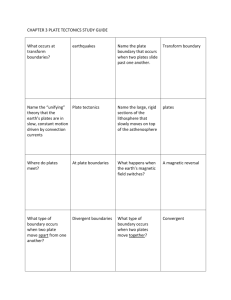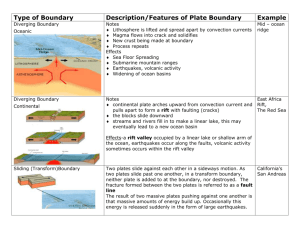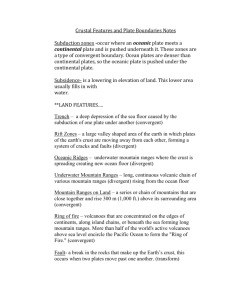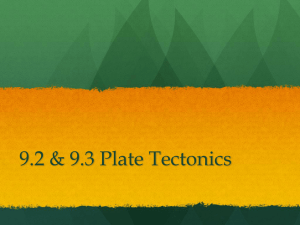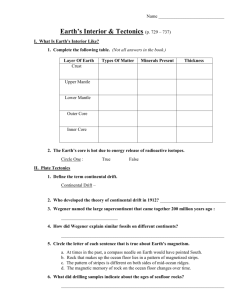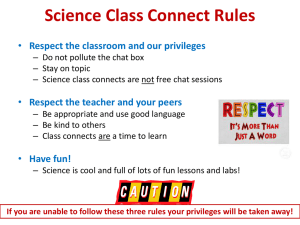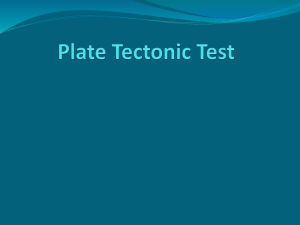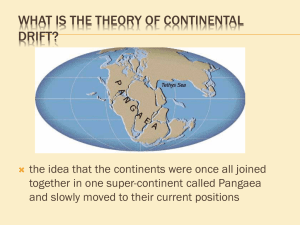C. two continental plates sliding by each other
advertisement
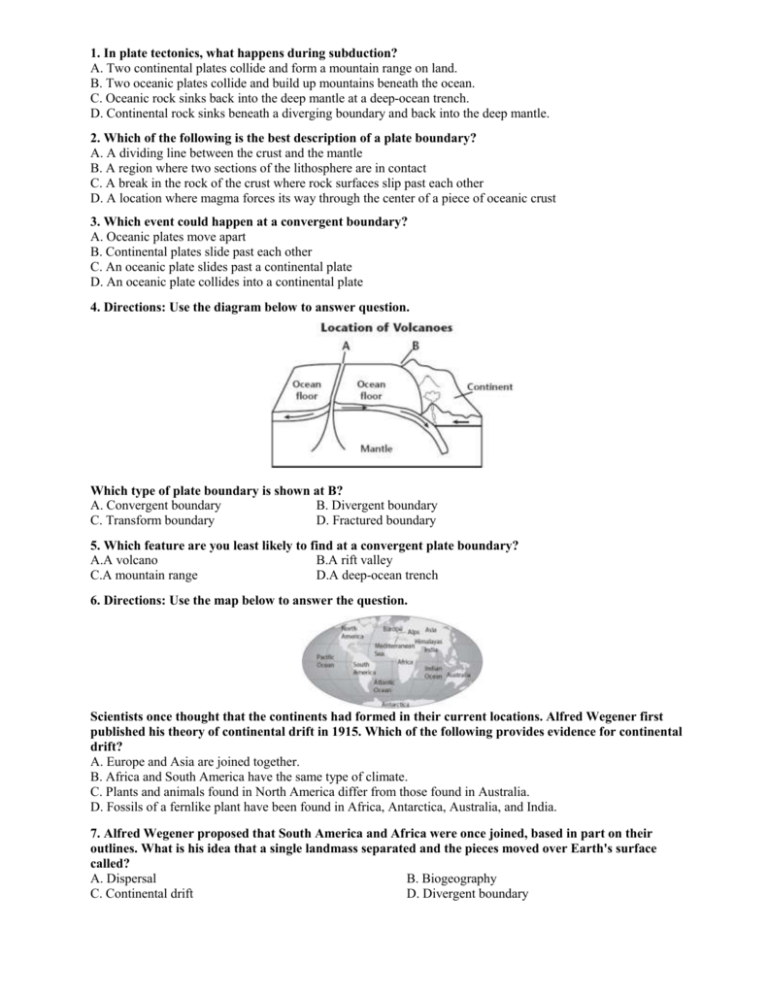
1. In plate tectonics, what happens during subduction? A. Two continental plates collide and form a mountain range on land. B. Two oceanic plates collide and build up mountains beneath the ocean. C. Oceanic rock sinks back into the deep mantle at a deep-ocean trench. D. Continental rock sinks beneath a diverging boundary and back into the deep mantle. 2. Which of the following is the best description of a plate boundary? A. A dividing line between the crust and the mantle B. A region where two sections of the lithosphere are in contact C. A break in the rock of the crust where rock surfaces slip past each other D. A location where magma forces its way through the center of a piece of oceanic crust 3. Which event could happen at a convergent boundary? A. Oceanic plates move apart B. Continental plates slide past each other C. An oceanic plate slides past a continental plate D. An oceanic plate collides into a continental plate 4. Directions: Use the diagram below to answer question. Which type of plate boundary is shown at B? A. Convergent boundary B. Divergent boundary C. Transform boundary D. Fractured boundary 5. Which feature are you least likely to find at a convergent plate boundary? A.A volcano B.A rift valley C.A mountain range D.A deep-ocean trench 6. Directions: Use the map below to answer the question. Scientists once thought that the continents had formed in their current locations. Alfred Wegener first published his theory of continental drift in 1915. Which of the following provides evidence for continental drift? A. Europe and Asia are joined together. B. Africa and South America have the same type of climate. C. Plants and animals found in North America differ from those found in Australia. D. Fossils of a fernlike plant have been found in Africa, Antarctica, Australia, and India. 7. Alfred Wegener proposed that South America and Africa were once joined, based in part on their outlines. What is his idea that a single landmass separated and the pieces moved over Earth's surface called? A. Dispersal B. Biogeography C. Continental drift D. Divergent boundary 8. Which event best describes why volcanoes form near location 2? A. Two plates are colliding. B. Two plates are separating. C. Two plates are sliding by each other. D. The subduction of a plate is occurring. 9. What event is likely to occur at plate boundary X? A. Volcanic activity C. The formation of mountain B. The formation of new ocean floor D. All the above 10. Approximately 50 million years ago, the Himalayan mountain range began forming in Asia. The formation of the Himalayas can most likely be explained by— A. two continental plates colliding B. two continental plates moving apart C. two continental plates sliding by each other D. an oceanic plate sinking below a continental plate 11. Alfred Wegener thought that today's continents were once connected, forming a supercontinent called Pangaea. Which of the following statements describes the best evidence to support Wegener's claim? A. Earthquakes occur randomly across Earth's surface. B. The age of sea floor rock increases the further away the rock is from the mid-ocean ridge. C. Sonar surveys in the North Pacific show profiles of flat topped, underwater volcanoes. D. Large-scale geological features on separated continents often match closely when models of the continents are moved together. 12. These diagrams show Wegener's idea about how Earth's landmasses have changed over time. What is the correct order of events, from oldest to most recent? A.1, 2, 3, 4 B.2, 3, 4, 1 C.2, 4, 3, 1 D.4, 2, 3, 1 13. How can you identify a canyon on a satellite view? A. It is an erosional feature. It appears darker than the surrounding areas. B. It is an erosional feature. It appears lighter than the surrounding areas. C. It is a depositional feature. It appears darker than the surrounding areas. D. It is a depositional feature. It appears lighter than the surrounding areas. 14. During a very cold winter, a large rock breaks into several smaller pieces. Which destructive force caused the change? A. Rain B. Ice C. Wind D. Gravity 15. On a topographic map, what do V-shaped contour lines pointing downhill indicate? A. A valley B. A ridge C. A hilltop D. A hollow 16. How would a river delta appear on a satellite view? A. A round blue area surrounded by a green area B. A round brown area surrounded by a blue area C. A fan-shaped brown area extending into a blue area D. A fan-shaped green area extending into a brown area A section of the topographic map of Saddle Butte, Texas is shown below. Based on the map, how would you describe Saddle Butte?A. The butte is a gently sloping hill rising out of the surrounding landscape. B. The butte is an irregularly shaped depression in the middle of flat ground. C. The butte is a short, steep-sided structure with a broad, flat top. D. The butte is a tall, steep-sided structure rising out of a flat landscape. 18. The model below shows the general movement of global winds. The paths of global winds along Earth's surface are shown with dashed lines. Why do the paths of global winds curve as illustrated rather than moving in a straight line? A. Differences in air temperature B. Differences in air pressure C. Earth's revolution around the sun D. Earth's rotation on its axis 19. The image shows three kinds of heat transfer in the troposphere. What kind of heat transfer is represented by the letter B? A. Convection B. Conduction C. Radiation D. All of the other answer choices 20. Scientists divide Earth's atmosphere into four main layers based primarily on a single characteristic. Which of the following tools would be most useful in measuring this characteristic? A. Anemometer B. Barometer C. Psychrometer D. Thermometer 21. What information can you learn from a weather map? A. Conditions at a particular time over a large area B. Conditions at a particular time over a small area C. Conditions at any time over a large area D. Conditions at any time over a small area 22. What type of front occurs when a warm air mass meets a cold air mass, but neither air mass can move the other? A. Cold front B. Warm front C. Stationary front D. Occluded front 23. How is convection in Earth's ocean currents similar to convection in Earth's atmosphere? A. Ocean currents drive the wind currents above them. B. They are both driven primarily by energy from the sun. C. They both transfer energy from Earth's poles to Earth's equator. D. They both result in global current belts that travel uninterrupted around Earth. 24. How does a hurricane form? A. It begins as a low-pressure area over cold ocean water. B. It begins as a high-pressure area over warm ocean water. C. It begins as a low-pressure area over warm ocean water. D. It begins as a high-pressure area over cold ocean water. 25. How does salinity of ocean water affect deep ocean currents? A. Salinity increases near the poles, and the water sinks to the ocean floor. B. Salinity decreases near the poles, and the water rises to the ocean surface. C. Salinity increases near the equator, and the water rises to the ocean surface. D. Salinity decreases near the equator, and the water sinks to the ocean floor. 26. A large stream of moving water that flows through the ocean is called A. a wave. B. a current. C. a seamount. D. an upwelling. 27. In both air and liquid water, heat can be transferred as a result of currents in which warm fluid moves up and cool fluid moves down. This transfer is called A. wind. B. radiation. C. convection. D. conduction. 31. Which type of heating is most responsible for warming the troposphere? A. Method B: radiation B. Method A: convection C. Method C: conduction D. Method B: convection 32. Which of the following human activities is most likely to threaten a renewable resource? A. Over-fishing the oceans B. Transporting materials on ships C. Making drinking water from saltwater D. Using ocean tides to produce electricity 33. What causes deep ocean currents? A. Winds pushing water across the surface of the ocean B. Warm and cold air masses meeting over the open ocean C. Salinity and temperature differences in ocean water D. The relative positions of the moon and the sun
